Friday Apr 04, 2025
Friday Apr 04, 2025
Thursday, 17 August 2023 00:30 - - {{hitsCtrl.values.hits}}
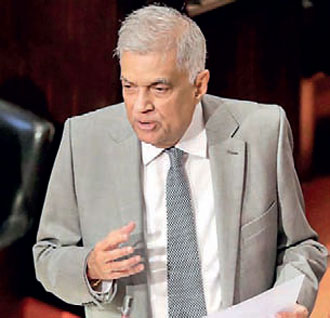
North and East Only Development Plan
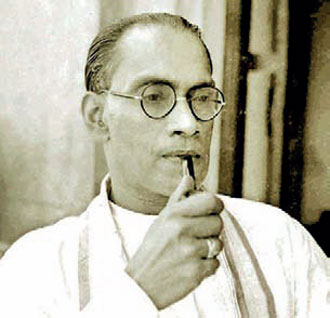
SWRD: Sovereignty and balance
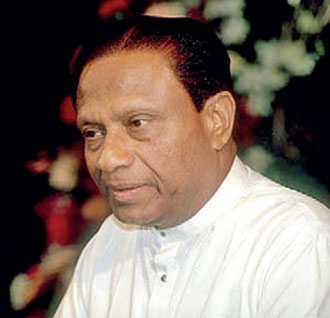
Ranasinghe Premadasa: Sovereignty restored (Pic by Getty Images)
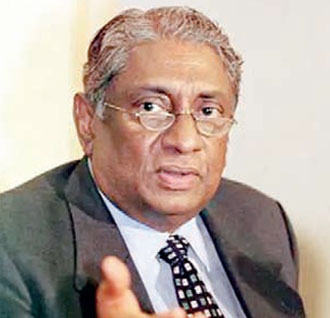
Lakshman Kadirgamar: Engagement, balance, equilibrium
“Ceylon was on the doorstep of CENTO when 1956 rescued our foreign policy from what would have been a disaster.”'
– Mervyn de Silva (1981)
 The British Empire was sufficiently discerning and mindful of the distinctiveness of this island that it chose not to run Ceylon from Delhi as part of the British Raj. Instead, it ran Ceylon directly from Whitehall, across oceans and continents.
The British Empire was sufficiently discerning and mindful of the distinctiveness of this island that it chose not to run Ceylon from Delhi as part of the British Raj. Instead, it ran Ceylon directly from Whitehall, across oceans and continents.
The British Empire’s grand strategy recognised the importance of the island and therefore located Lord Mountbatten’s wartime headquarters here, not in India. (His transmitters became Radio Ceylon after Independence). Military historians have designated the failure of the Japanese attacks of April 1942 on Trincomalee and Colombo as a turning point of WW II in the East.
Ranil Wickremesinghe, far less sagacious, is far less respectful of our exceptionality and value, except in the crassest market terms.
Neighbour’s poodle
In the context of great power rivalry in the Indo-Pacific and the closer frame of big power rivalry in Asia including south Asia, if a sizeable sphere including strategically significant Trincomalee is donated to one of the contenders, India, enabling it to extend downwards incorporating Sri Lanka’s North and East, then Sri Lanka cannot but be perceived by China’s strategic planners to have tilted to, allied with, and become an adjunct of its Asian competitor, plugged-in by extension to the Quad. If Trincomalee-centred Eastern Sri Lanka becomes an Indian enclave, Sri Lanka becomes a Quad enclave.
Accommodating a Chinese foothold in Sri Lanka’s southern two-thirds will not allay Beijing’s concerns, but only help fissure the island into two competing spheres of external influence.
China has been a consistent friend and partner of Sri Lanka. Lakshman Kadirgamar maintained an equilibrium between India, China and the US.
Why then is Ranil doing this? Though it is manifestly against our national interests, it is perfectly congruent with, and a throwback to, the behaviour of Sir John Kotelawala, the UNP’s post-Hartal 1953 choice as PM, and the thinking of his advisor, Esmond Wickremesinghe, Ranil’s father. Mangala Samaraweera rightly bracketed Sir John and Ranil in the same category.
Mervyn de Silva spotlights the external relations stakes in 1956:
 “…the physical underpinning of US strategy, was the establishment of CENTO in the Middle East and SEATO in South East Asia. It dragged Third World countries into the vortex of the Cold War, even as the new leaders of Asia and Africa were meeting in Bandung again in the month of April 1955. Ceylon was represented at Bandung by Sir John Kotelawala, a brash anti-communist crusader perfectly attuned to the spirit of the Dullasian era. Ceylon was on the doorstep of CENTO when 1956 rescued our foreign policy from what would have been a disaster. And now we are back in a new cold war, with military budgets soaring, new alliances and new bases being established, and the Indian Ocean emerging as the main arena of confrontation and tension…”
“…the physical underpinning of US strategy, was the establishment of CENTO in the Middle East and SEATO in South East Asia. It dragged Third World countries into the vortex of the Cold War, even as the new leaders of Asia and Africa were meeting in Bandung again in the month of April 1955. Ceylon was represented at Bandung by Sir John Kotelawala, a brash anti-communist crusader perfectly attuned to the spirit of the Dullasian era. Ceylon was on the doorstep of CENTO when 1956 rescued our foreign policy from what would have been a disaster. And now we are back in a new cold war, with military budgets soaring, new alliances and new bases being established, and the Indian Ocean emerging as the main arena of confrontation and tension…”
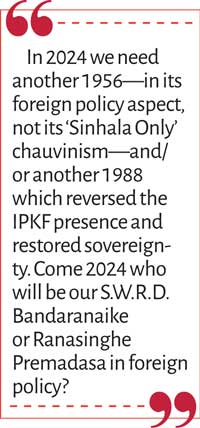 (‘April anniversaries, Teilhard de Chardin seminar April 1981, republished in ‘Crisis Commentaries: Selected Political Writings of Mervyn de Silva’, ICES Colombo 2001, p43.)
(‘April anniversaries, Teilhard de Chardin seminar April 1981, republished in ‘Crisis Commentaries: Selected Political Writings of Mervyn de Silva’, ICES Colombo 2001, p43.)
In 2024 we need another 1956—in its foreign policy aspect, not its ‘Sinhala Only’ chauvinism—and/or another 1988 which reversed the IPKF presence and restored sovereignty. Come 2024 who will be our S.W.R.D. Bandaranaike or Ranasinghe Premadasa in foreign policy?
‘North-East Only’ development
Wickremesinghe’s crucially important parliamentary discourse of 9 August 2023 unveils a mega-blueprint to economically re-zone the country, install a new geo-economy in the North and East as the engine of growth, shifting the island’s centre of gravity and creating two de facto countries on one island, one of which would be integrated with the neighbouring big power.
As a member of the North-East Provincial Council cabinet and the youngest Minister in the Provincial Council system at its post-Accord inception in 1988, I caution that the situation of the Sinhala and Muslim minorities in the Trincomalee district and the Eastern province under Ranil’s policy of Indianization will be uncertain as the island’s centre of gravity shifts with the convergence with India, and especially fraught because India is currently dominated by Hindutva ideology.
The concluding segment of Ranil’s speech is captioned ‘Development Plans for North and East’ and contains 10 substantive paragraphs. Not a single paragraph of his entire speech was devoted, however briefly, to the development of any other province or the other 7 provinces taken together, which have a provincial council each.
“Development Plans for North and East
 It is imperative to create extensive and practicable Plans to develop the Northern and Eastern Provinces. Anticipating that renewable energy could meet 70% of the country’s national electricity need by 2030, one of the key objectives of the both Northern and Eastern Development Plans is to harness the region’s renewable energy potential through the production of green hydrogen and green ammonia using innovative technologies. This strategy aims to attract investments and could transform the Port of Colombo, Pooneryn and even Trincomalee as hubs for export of green hydrogen.
It is imperative to create extensive and practicable Plans to develop the Northern and Eastern Provinces. Anticipating that renewable energy could meet 70% of the country’s national electricity need by 2030, one of the key objectives of the both Northern and Eastern Development Plans is to harness the region’s renewable energy potential through the production of green hydrogen and green ammonia using innovative technologies. This strategy aims to attract investments and could transform the Port of Colombo, Pooneryn and even Trincomalee as hubs for export of green hydrogen.
 We have already taken steps on creating a conducive environment for the investment and export of solar and wind power, culminating in a Memorandum of Understanding with India to facilitate collaborative efforts in this area. Adani Group has come forward to invest in the renewable energy sector of Sri Lanka. I believe that this collaborative approach would lead to substantial growth in this area.
We have already taken steps on creating a conducive environment for the investment and export of solar and wind power, culminating in a Memorandum of Understanding with India to facilitate collaborative efforts in this area. Adani Group has come forward to invest in the renewable energy sector of Sri Lanka. I believe that this collaborative approach would lead to substantial growth in this area.
 Additionally, the “Water to the North” programme, comprises the development of various water ways. In this context the Government has already approved the projects for the Poonekeri Tank and Malwathu Oya irrigation which is being prioritized.
Additionally, the “Water to the North” programme, comprises the development of various water ways. In this context the Government has already approved the projects for the Poonekeri Tank and Malwathu Oya irrigation which is being prioritized.
 Talks are presently continuing on the River for Jaffna, which would bring fresh water to the Jaffna Lagoon and increase the capacity of the Iranamadu Tank. The Small Tanks Renewal Project, is important to be accomplished. In fact, this project will give rise to developing the agricultural and solar energy sectors in the Northern Province.
Talks are presently continuing on the River for Jaffna, which would bring fresh water to the Jaffna Lagoon and increase the capacity of the Iranamadu Tank. The Small Tanks Renewal Project, is important to be accomplished. In fact, this project will give rise to developing the agricultural and solar energy sectors in the Northern Province.
 In addition to this, the Economic sub-committee of Cabinet is today considering two Cabinet Papers. One by the Minister of Irrigation and the other by the Minister of Water Supply to look at the development of water supply of the Jaffna peninsula and other Projects.
In addition to this, the Economic sub-committee of Cabinet is today considering two Cabinet Papers. One by the Minister of Irrigation and the other by the Minister of Water Supply to look at the development of water supply of the Jaffna peninsula and other Projects.
 There will be a committee chaired by my senior advisor Dr. R. Samaratunga to look at them and make a combined plan.
There will be a committee chaired by my senior advisor Dr. R. Samaratunga to look at them and make a combined plan.
 It is also essential to upgrade air and sea connectivity in the North. The development of the KKS Harbour, Vavuniya and Palali Airports and the ferry service connecting the Northern Province to the South of India are facilities which have been earmarked.
It is also essential to upgrade air and sea connectivity in the North. The development of the KKS Harbour, Vavuniya and Palali Airports and the ferry service connecting the Northern Province to the South of India are facilities which have been earmarked.
 The establishment of Investment Promotion Zones in KKS, Paranthan and Mankulam are being worked towards. I will get the Board of Investment (BOI) to take these over. We also have plans for the development of tourists’ attractions in Jaffna and Mannar, through a tourist boating project around Mannar Fort, Kankesanthurai Port, the Islands and Vadam-arachchi. Under an Agriculture Modernization programme, we will seek to promote coconut cultivation in the Vanni. Jaffna being home to a seat of excellence in higher education with its University, would lend to developing it as a University City. Additionally, land has been identified in KKS for the establishment of a Campus under the aegis of SLIIT.
The establishment of Investment Promotion Zones in KKS, Paranthan and Mankulam are being worked towards. I will get the Board of Investment (BOI) to take these over. We also have plans for the development of tourists’ attractions in Jaffna and Mannar, through a tourist boating project around Mannar Fort, Kankesanthurai Port, the Islands and Vadam-arachchi. Under an Agriculture Modernization programme, we will seek to promote coconut cultivation in the Vanni. Jaffna being home to a seat of excellence in higher education with its University, would lend to developing it as a University City. Additionally, land has been identified in KKS for the establishment of a Campus under the aegis of SLIIT.
 Similarly plans for developing the Eastern Province are progressing with Trincomalee being the core. India’s assistance as our closest neighbour in implementing the Trincomalee District Development Project is of immense value to Sri Lanka.
Similarly plans for developing the Eastern Province are progressing with Trincomalee being the core. India’s assistance as our closest neighbour in implementing the Trincomalee District Development Project is of immense value to Sri Lanka.
 The ongoing cooperation in the development of the Trincomalee Tank Farms and India’s agreement to further enhance Trincomalee as a national and regional hub of industry, energy and economic activity is a fillip for developing further mutually beneficial cooperation.
The ongoing cooperation in the development of the Trincomalee Tank Farms and India’s agreement to further enhance Trincomalee as a national and regional hub of industry, energy and economic activity is a fillip for developing further mutually beneficial cooperation.
 The Eastern Province plays an important role in naval affairs and Trincomalee should be made into a leading strategic Port. It is important that we work together with India when developing the Eastern Province Port, by having discussions on several programmes in that region.
The Eastern Province plays an important role in naval affairs and Trincomalee should be made into a leading strategic Port. It is important that we work together with India when developing the Eastern Province Port, by having discussions on several programmes in that region.
 Further we cannot limit the economic activities of this Port solely to the Trincomalee District. This should be connected with the cities of Anuradhapura, Vavuniya and Dambulla, especially when the districts of Vanni, Eastern and North Central Provinces are responsible for the bulk of agricultural production. Since India has a lead to develop industries in this Province, an Industrial Zone should be created. The Port therefore will also be connected and we are planning to establish a Joint Task Force for this purpose.
Further we cannot limit the economic activities of this Port solely to the Trincomalee District. This should be connected with the cities of Anuradhapura, Vavuniya and Dambulla, especially when the districts of Vanni, Eastern and North Central Provinces are responsible for the bulk of agricultural production. Since India has a lead to develop industries in this Province, an Industrial Zone should be created. The Port therefore will also be connected and we are planning to establish a Joint Task Force for this purpose.
 From an economic point of view the Eastern Province has much to offer the tourism industry. In particular, there is the cultural triangle of Anuradhapura, Polonnaruwa and Dambulla, which is in close proximity to the Eastern Province and could be a natural route for enhanced visits by tourists to the beach fronted cities of Batticaloa, Arugam Bay and Trincomalee. Cab-inet also approved Subana Jurong to cover planning from Werugalaaru to Arugam Bay for tourism purposes.
From an economic point of view the Eastern Province has much to offer the tourism industry. In particular, there is the cultural triangle of Anuradhapura, Polonnaruwa and Dambulla, which is in close proximity to the Eastern Province and could be a natural route for enhanced visits by tourists to the beach fronted cities of Batticaloa, Arugam Bay and Trincomalee. Cab-inet also approved Subana Jurong to cover planning from Werugalaaru to Arugam Bay for tourism purposes.
 Cruise tourism initiatives could also be a part of this development plan. The fisheries, agriculture and animal husbandry sectors are well poised for modernization in the Eastern Province. In this context, the opening of Land Systems A and B of the Mahaweli right bank will provide the much-needed impetus for enhancing agricultural pursuits…”
Cruise tourism initiatives could also be a part of this development plan. The fisheries, agriculture and animal husbandry sectors are well poised for modernization in the Eastern Province. In this context, the opening of Land Systems A and B of the Mahaweli right bank will provide the much-needed impetus for enhancing agricultural pursuits…”
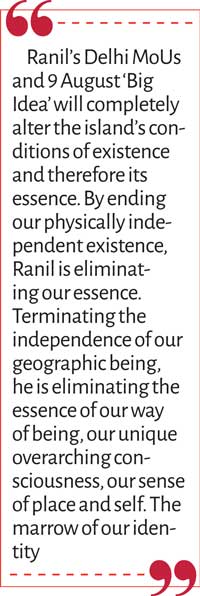 Ranil’s development strategy ‘holographically’ projected in his speech is as follows:
Ranil’s development strategy ‘holographically’ projected in his speech is as follows:
a. Cede the Northern and Eastern provinces to India (especially Adani), inviting it to convert the Trincomalee district and the entire Eastern province into an economic base which can be used as beachhead/springboard for projecting Indian economic power and presence into Anuradhapura.
b. Enlarge the Eastern province economically to incorporate the North Central Province – part of the island’s historic heartland—and thereby make the Sinhala heartland economically dependent on India.
c. Permit the Indian footprint to cover the North and East and secure a toehold in the NCP, even surging, driven by the BJP’s ‘pan-Indian’ ideology, from the Eastern province to the adjacent Hill-country.
d. Liquidate the State in the Sri Lankan economy, thereby weaken the Sri Lankan state by depleting its resource base; consciously develop only the North and East, and damn the rest.
Probable results are:
I. One part of the island will be characterized by rapid development and the other by rapid underdevelopment. Irrigation projects for the North and East are listed, but there are none for the rest of the island despite the ongoing rural crisis and Vasudeva Nanayakkara’s plea in parliament for the diversion of the Kalu Ganga.
II. The North and East will be turned into the epicentre of growth, while the rest of the island – the ‘Greater South’-- will be sold-off to the highest/fastest bidder; its multiethnic, multireligious, multilingual, multicultural multitude ‘triaged’, economically dislocated in their own homeland. Ranil’s development plan may be summed-up as “Uthuru-Nagenahirata kiri, apata kekiri” (“milk for the North and East, melon for the rest of us”).
‘Bheeshana’ Vibheeshana and the whale
Ranil, a leader we never chose, is feeding this island into the whale’s maw. Prime Minister Modi has just denounced the late Indira Gandhi, victor of the Bangladesh war and mother of India’s nuclear bomb, for agreeing to Sri Lankan sovereignty over Katchatheevu Island, which he regards as a part of India:
‘Prime Minister Narendra Modi on Thursday blamed the Congress for the partition of India and also said it was the Indira Gandhi government which gave the Katchatheevu Island to Sri Lanka in 1974. The island, located between Rameswaram (India) and Sri Lanka, was traditionally used by both Sri Lankan and Indian fishermen. In 1974, then Prime minister Indira Gandhi accepted Katchatheevu as Sri Lankan territory under the “Indo-Sri Lankan Maritime Agreement”.
“These people divided mother India into three parts for politics…” the prime minister said in Lok Sabha, launching a blistering attack on the Congress during his reply to a debate on a no-confidence motion.
The prime minister said the DMK government in Tamil Nadu keeps writing to him urging to bring Katchatheevu back to India.
“Katchatheevu is an island between Tamil Nadu and Sri Lanka. Somebody gave it to another country. It happened under the leadership of Indira Gandhi,” he said.
“Wasn’t that part of Maa Bharati there?” Modi asked...’ (Indira Gandhi government gave Katchatheevu Island to Sri Lanka: PM Modi - Breaking News | Daily Mirror)
The Ramayana lives in the mind of India’s ruling-elite. No Lankan leader should solicit and facilitate the southward thrust of a giant neighbour with a deliriously self-glorifying, expansionist, operative cosmology. Ranil has revealed Vibheeshana (Ravana’s betrayer) as his role-model. ‘Vibheeshana and (Batalanda) Bheeshana’ is the motto.
Ranil is ending our unique geohistorical story of millennia, which is quintessentially one of self-definition, demarcating our island home from the neighbouring landmass, its ‘Brahminic’ ethos, and its hostile Southern cone.
‘Existence precedes essence’, said Jean-Paul Sartre. Ranil’s Delhi MoUs and 9 August ‘Big Idea’ will completely alter the island’s conditions of existence and therefore its essence. By ending our physically independent existence, Ranil is eliminating our essence. Terminating the independence of our geographic being, he is eliminating the essence of our way of being, our unique overarching consciousness, our sense of place and self. The marrow of our identity.
Is it for annexation by or ceding to India of the North and East, and the placing of Sinhala and Muslim minorities in the East under Indian dominance, that the Sri Lankan military fought a war for 30 years, vanquishing a formidable and fanatical separatist enemy on those very battlefields which they reunited with the South and restored the island’s territorial unity and integrity, its organic wholeness?
Zombie democracy and devolution
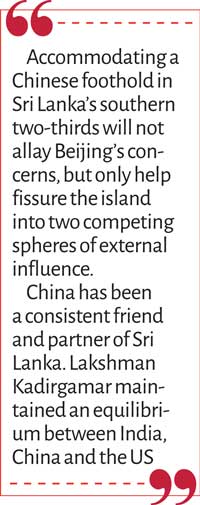 On 9 August President Ranil Wickremesinghe waded into political philosophy, disastrously. He raised a fundamental question and proffered a ridiculous reply:
On 9 August President Ranil Wickremesinghe waded into political philosophy, disastrously. He raised a fundamental question and proffered a ridiculous reply:
 “What characterizes modern democracies? The establishment of decentralized governance as opposed to devolution...” (ibid)
“What characterizes modern democracies? The establishment of decentralized governance as opposed to devolution...” (ibid)
“What characterizes modern democracies” has nothing to do with “the establishment of decentralized governance”. Addressing the Global Summit on Democracy, President Biden dealt correctly with the same question, defining democracies as countries where “leaders are freely elected by the people”.
“The establishment of decentralized governance as opposed to devolution” is Wickremesinghe’s political Freudian slip. What he is proposing in his speech is not devolution, i.e., sharing, transferring power, but the de-centralization of administration while concentrating greater political power in himself, an unelected leader. He seeks to transfer additional power to the administrative skeleton of the Provincial Councils while creating clusters such as advisory bodies to the Governor consisting of elected MPs plus officials.
He is erecting a multipurpose structure which is simultaneously:
 A network of patronage tunnels
A network of patronage tunnels
 A top-down political authority as subsystem of the presidency
A top-down political authority as subsystem of the presidency
 A grid of political silos housing the matrix of Indian suzerainty and its interface with the client President.
A grid of political silos housing the matrix of Indian suzerainty and its interface with the client President.
Our Sunday sister-paper confirms that “…The execution of these aspects is bound to push back indefinitely the conduct of Provincial Council (PC) elections…” Without elected PCs and an elected President, any discussion about devolution is vacuous. Ranil doesn’t want live Provincial Councils. He wants a zombie 13 Plus, in a zombie democracy.
Discover Kapruka, the leading online shopping platform in Sri Lanka, where you can conveniently send Gifts and Flowers to your loved ones for any event including Valentine ’s Day. Explore a wide range of popular Shopping Categories on Kapruka, including Toys, Groceries, Electronics, Birthday Cakes, Fruits, Chocolates, Flower Bouquets, Clothing, Watches, Lingerie, Gift Sets and Jewellery. Also if you’re interested in selling with Kapruka, Partner Central by Kapruka is the best solution to start with. Moreover, through Kapruka Global Shop, you can also enjoy the convenience of purchasing products from renowned platforms like Amazon and eBay and have them delivered to Sri Lanka.
Discover Kapruka, the leading online shopping platform in Sri Lanka, where you can conveniently send Gifts and Flowers to your loved ones for any event including Valentine ’s Day. Explore a wide range of popular Shopping Categories on Kapruka, including Toys, Groceries, Electronics, Birthday Cakes, Fruits, Chocolates, Flower Bouquets, Clothing, Watches, Lingerie, Gift Sets and Jewellery. Also if you’re interested in selling with Kapruka, Partner Central by Kapruka is the best solution to start with. Moreover, through Kapruka Global Shop, you can also enjoy the convenience of purchasing products from renowned platforms like Amazon and eBay and have them delivered to Sri Lanka.